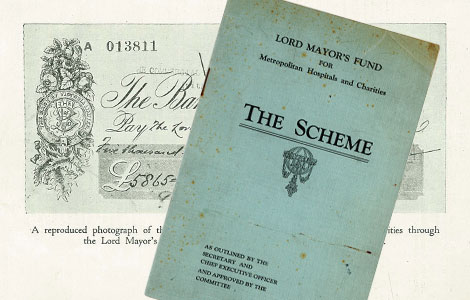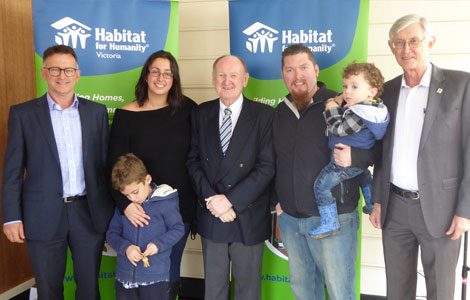Our history shows that we have been a major contributor to Melbourne's health and wellbeing through our grantmaking to public hospitals and charitable organisations.
We have always been prepared to identify emerging issues and provide grants to minimise the impact of these issues on our community.
We continue to be visionary and have our eye on the future. This is achieved through our research, grants program and our support of collective giving, social impact investment and social enterprise.
Scroll through some of the key aspects of our history:

Sir John Swanson, founder
Lord Mayor of Melbourne Sir John Swanson is acknowledged as the founder and first president of Lord Mayor’s Fund for Metropolitan Hospitals and Charities.
Sir John was a councillor at the City of Melbourne for almost 10 years from 1914 to 1923 and Lord Mayor from 1920 to 1923. It was during his time as a councillor he realised that Melbourne needed a central and organised fundraising scheme to support the city’s hospitals and charitable organisations to enhance their ability to respond to the healthcare needs of a growing population and the rehabilitation needs of returned servicemen and servicewomen from World War I. He envisioned an endowment fund that would grow an income in perpetuity so that hospitals and charities would have access to additional source of funding.

Workplace Giving
A new giving program was introduced to workplaces that would see employees from all industries and sectors contributing a weekly donation to the Fund from their wages. This was a very early concept of workplace giving and became the Fund’s Industrial Contribution Scheme. By 1925, 80,000 people from 1,500 organisations were signed up to the Fund’s workplace giving scheme. The scheme was extended in 1927 to include employees from the banking, insurance, media, commercial and business sectors. Workplace giving became an important revenue stream for the Fund.

Flower Day
Flower Day was a very important and successful fundraising appeal for Lord Mayor’s Fund for Metropolitan Hospitals and Charities. Launched in 1925, it ran for almost 50 years raising millions of pounds and dollars for public hospitals. It also activated Melbourne’s sense of unity as a caring community. The main Flower Day appeals comprised of Flower Day, Rose Day and Wattle Day, with each day representing a social issue. By the 1970s the Flower Day appeals were phased out, however in 2013 Lord Mayor’s Charitable Foundation reintroduced Flower Day for three years as part of the Foundation’s 90th anniversary celebrations.

Heart of Melbourne Appeal
In 2006 the Heart of Melbourne Appeal was launched as a new high-profile fundraising campaign to support charitable organisations providing services for people experiencing homelessness. It was widely publicised by Melbourne’s media, and many well-known Melburnians lent their support to help promote the appeal. The Heart of Melbourne Ball became an important fundraising event for the appeal for a number of years.

Feed Melbourne Appeal
From 2010 to 2016 the Foundation worked in partnership with Leader Community News and FareShare to fundraise and provide grants to organisations providing food and emergency care to vulnerable people as part of Feed Melbourne. The appeal also helped to raise the issue of homelessness and food security in Melbourne. This year Leader Community News supported our Changing Melbourne for Good campaign.

Innovation in Grantmaking
Grants Program
In 2013 the Foundation began the process of creating four defined impact areas in which to provide grants and that reflected Melbourne's social issues. Today these include Education & Employment, Environment & Sustainability, Homelessness & Affordable Housing, and Healthy & Resilient Communities. The Foundation added proactive and initiative grants to provide opportunities to work with others on tough challenges.
Grants Challenges
In 2014 the Foundation launched a new grants program ‘Challenge’ to seek out innovative new solutions to address ongoing issues and provide funding opportunity to test ideas. The Seed Challenge focused on creating employment for people with disability while the Innovation Pitch focused on providing major funding for new solution ideas. The Foundation is now undertaking an Affordable Housing Challenge.

Global philanthropy trends
Social Impact Investment
Following global philanthropy trends, the Foundation launched its first social impact investment program with social investments made to Yume, Hire Up and Habitat for Humanity in 2016/17.
Collective Giving
With the launch of collective giving, the Foundation welcomed two of Melbourne’s most prominent giving circles Impact100 Melbourne and Melbourne Women’s Fund, our eleven Community Funds and the pilot of our new Hives.
Sustainable Development Goals (SDG)
In 2015 the United Nations launched its new sustainable development agenda with 17 goals to be achieved within 15 years. The Foundation adopted this program in 2016 aligning its Impact Areas to the goals. We are now working to connect our impact evaluation reporting to the SDG indicators and will connect Vital Signs 2019 with this framework.
Collaborative Giving
Today, we are working collaboratively with other funders and experts from other sectors to build our capacity to tackle some tough projects, such as response to the lack of supply of affordable housing.